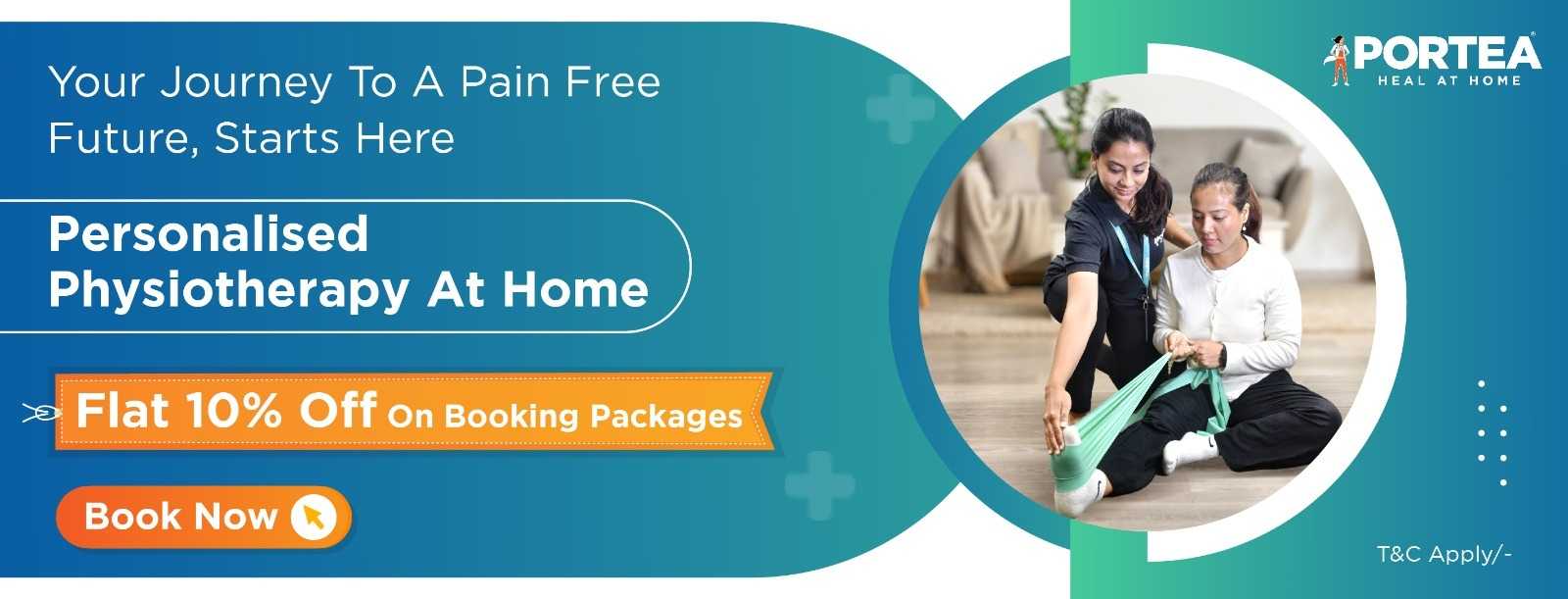Expert Physiotherapy at Home
Certified physiotherapists visit you at home to provide focused, one-on-one care tailored to your needs. With no travel or waiting rooms, recovery happens in a setting that is comfortable, familiar, and built around your convenience.
Personalised Recovery Programmes
Every treatment plan is designed to suit your condition, goals, and pace. Our physiotherapists follow structured, evolving protocols to ensure consistent progress, with each session aligned to deliver meaningful results.
Trusted Physiotherapists. Real Results.
Our team comprises experienced, background-verified physiotherapists trusted by thousands of families. With a strong focus on safety, reliability, and clinical outcomes, we make recovery at home both effective and reassuring
Patient Testimonials
Portea Physiotherapists for Home Visits
Meet some of our experienced and dedicated healthcare professionals

Dr. Lokesh G
Physiotherapist
Specializations
Experienced in Neurological rehabilitation, Orthopaedic physiotherapy, and Paediatric care
Delivers structured, high-impact treatment plans across neuro, ortho, and paediatrics—ensuring safety, comfort, and measurable recovery at every stage.

Dr. Mohammed Sarwar
Physiotherapist
Specializations
Experienced in Neurological rehabilitation, Adult physiotherapy, and Paediatric care
Combines deep clinical expertise with a compassionate approach, supporting both adults and children through neuro and physical rehabilitation that promotes long-term independence and recovery.

Dr. Nelapati Divya
Physiotherapist
Specializations
Skilled in Orthopaedic rehabilitation, Manual therapy techniques, and Paediatric physiotherapy
Brings a personalised, hands-on approach to healing—combining structural expertise with paediatric sensitivity to restore movement, relieve pain, and improve everyday function.

Dr. Naveen V
Physiotherapist
Specializations
Trained in Pain management, Cardiac and Orthopaedic rehabilitation, Neurological care, and Neural tissue mobilisation
Brings clinical precision and empathy together—designing science-backed recovery protocols for pain relief, nerve mobilisation, and cardio-neuro-ortho rehabilitation across all age groups

Dr. Miloni Savla
Physiotherapist
Specializations
Holds an MPT in Orthopaedics with a focus on Musculoskeletal rehabilitation and strength recovery
Delivers focused, movement-oriented therapy grounded in orthopaedic science—helping patients rebuild strength, restore function, and return to daily life with confidence

what is an acetabular labrum/hip labral tear?
The acetabular labrum is a ring of fibrous cartilage that surrounds the acetabulum of the hip. Any damage to its tissues and cartilage is known as hip labral tear or acetabular labral tear. These labral injuries can occur due to various reasons such as an accident or an effect of repetitive stress on the hip joint.
Hip labral tear may also happen due to the following reasons:
- Body abnormalities
- Weak hip muscles
- An unstable hip joint
- Activities that require long-distance running and repetitive twisting of the body
- Improper technique during repetitive activities
A hip labral tear can cause pain in the hip and groin but in some cases, there are no symptoms. Once torn, the labral tear does not get healed on its own. You will require proper diagnosis and treatment to avoid further complications.
types of hips labral tear
Depending on their location, hips labral tears are classified into two types:
Anterior Labral Tear: This type of hip labral tear is quite common and is located in the front of the hip. It usually occurs due to stress on the hip joint due to repetitive activity.
Posterior Labral Tear: Located at the back of the hip, it usually occurs due to activities that put stress on the back of the hip joint.
how is it diagnosed?
Since it is difficult to diagnose hip labral tear, you may have to undergo one or more tests for an accurate diagnosis. Here are some of the tests you can expect:
Physical Examination: Your doctor will conduct a physical examination to check symptoms such as instability and pain to see if there is any damage done to the hip. He or she may ask you to move your legs or walk a bit to see if you feel any discomfort.
MRI: This test is done to visualize the internal injuries and check if you have a tear or not.
X-Ray: In case you have had a traumatic event or injury recently, the doctors will suggest X-Ray. This test can also diagnose problems with the hip bones, such as femoroacetabular impingement, or osteoarthritis that can cause labral tear.
Depending on the diagnosis and type of labral tear, the doctors will chart out a treatment plan. The treatment usually involves medication and physiotherapy. In rare cases, surgery can also be recommended.
how can physiotherapy help?
If you are diagnosed with a torn labrum, you can consult a physiotherapist to treat the damaged tissues. Below are some ways hip labral tear physiotherapy can help you:
- Alleviate pain by using therapies such as applying ice.
- Manual therapy is done to gently move your muscles and joints to improve motion and strength.
- Self-stretching techniques to ensure you do not end up hurting yourself more.
- Teaching you about physical exercises that can strengthen your muscles and ensures proper posture.
- Based on your assessment and improvement, physiotherapy helps in teaching controlled movements to avoid any further injury in the future.
To know more about how physiotherapy can treat your labral tear, consult a Hip Labral Tear physiotherapist who is qualified and experienced.
role of a physiotherapist
A physiotherapist plays a vital role in treating and healing your labral tear. Unlike the common notion that physiotherapists only inform you about exercises, there are various other responsibilities that a physiotherapist has to fulfill. Some of the common ones are as follows:
- Physiotherapists offer proper diagnosis of injuries before providing treatment.
- Physiotherapist understands the labral pathology and prepares an effective treatment plan.
- A good physitherapist ask you questions about your health and suggest therapies you are comfortable with.
- A physiotherapist also prepares a number of exercises that not only treat you but strengthen your muscles.
- A physiotherapist also educates and offers awareness about proper body postures and movements to improve your lifestyle.
- A physiotherapist also informs you about the precautions you should take to avoid further damage to your injury.
A good physiotherapist for Hip Labral Tear can provide you life-long lessons about healthy body movements. Thus, always consult one who is highly qualified and experienced to get proper care and treatment.
how can portea help?
At Portea, we recognize that selecting the ideal physiotherapist for an Acetabular Labrum or Hip Labral Tear can be daunting. That’s why we’ve curated a list of top physiotherapists for you. Based on their experience, specialization, availability, and pricing, you can choose the one that best physiotherapy for hip labral tear based on your needs. Here’s how Portea enhances your experience:
- We are equipped with advanced diagnostic tools specifically for labral tear assessment.
- Valuing your time, we offer consultations that align with your schedule.
- Experience the convenience of home visits; our physiotherapists come to you, providing treatment in the comfort and privacy of your home.
- Our team of physiotherapists isn’t just highly experienced and qualified – they’re also deeply empathetic. They understand each patient’s unique needs and tailor the treatment accordingly.
With Portea, you’re not just getting a service ; you’re gaining a partner in your journey to recovery and well-being. We also offer a range of superior healthcare services, including doctor consultations, medical equipment, nursing home care, and dedicated caretakers. Rely on us for top-tier healthcare solutions tailored to your requirements.
faqs
Is it ok to walk with hip labral tear?
Walking with a hip labral tear is generally okay, but it should be done cautiously. Pay attention to your body’s signals; if walking exacerbates pain or discomfort, it’s advisable to rest. Gentle, low-impact walking can maintain mobility, but avoid overexertion. Consult with a healthcare professional for personalized advice based on your specific condition.
What is the best exercise for a hip labral tear?
The best exercises for a hip labral tear focus on strengthening and stabilizing the hip area:
- Bridge Exercises: Lie on your back, bend knees, lift hips to strengthen glutes.
- Quadruped Hip Extensions: On hands and knees, extend one leg back.
- Clamshells: Lie on side, knees bent, open and close legs like a clamshell.
- Seated Hip Flexion: Sit on a chair, lift and lower one leg at a time.
- Supine Leg Lifts: Lie on back, lift one leg keeping it straight, then alternate.
Consult a physiotherapist for personalized guidance and to ensure these exercises are safe for your specific condition.
How long does a hip labral tear take to heal?
The healing time for a hip labral tear varies, typically ranging from several weeks to months, depending on severity and treatment. Non-surgical methods like physiotherapy may require a few months, while post-surgical recovery can take longer. Consistent rehabilitation and adherence to medical advice are key for effective healing.
Which food is best for hip labral tear?
For healing a hip labral tear, focus on anti-inflammatory foods: omega-3 rich fish, like salmon and mackerel; nuts and seeds; leafy greens; berries; and spices like turmeric and ginger. These foods can reduce inflammation and aid in healing. Also, calcium-rich foods and vitamin D are essential for bone health.
What to avoid with a hip labral tear?
With a hip labral tear, avoid high-impact activities like running or jumping that can exacerbate the injury. Steer clear of deep squats and heavy lifting. Also, minimize activities causing pain or discomfort in the hip area. Rest is important, but balance it with gentle, physician-approved exercises to maintain mobility.
References
Doctor Consultation
Nursing
Physiotherapy
Trained Attendant
Elder Care
Mother & Baby Care
Lab Tests
Medical Equipment
Speciality Pharma
Critical Care





